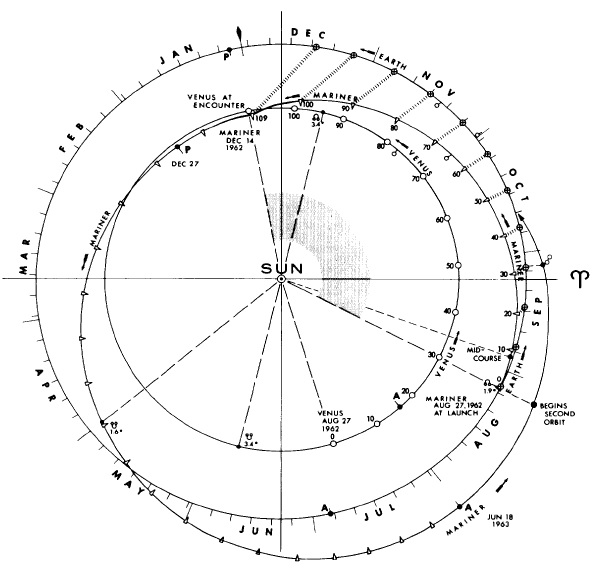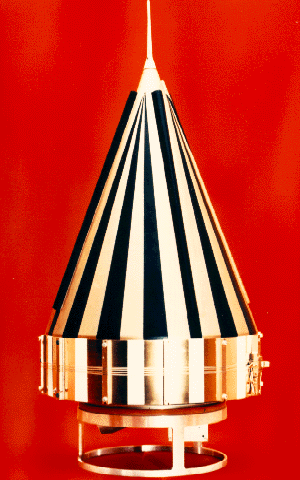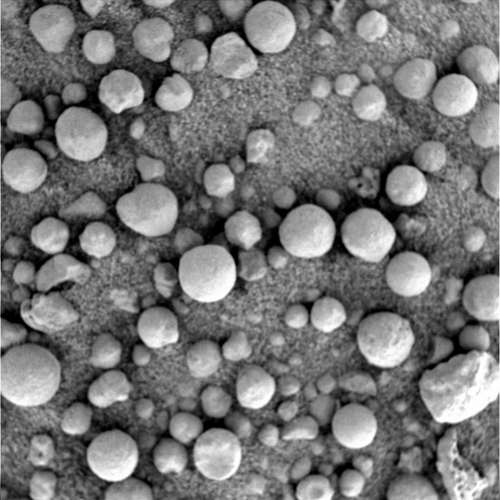|
Mariner 1
Mariner 1, built to conduct the first American planetary flyby of Venus, was the first spacecraft of NASA's interplanetary Mariner program. Developed by Jet Propulsion Laboratory, and originally planned to be a purpose-built probe launched summer 1962, Mariner 1's design was changed when the Centaur proved unavailable at that early date. Mariner 1 (and its sibling spacecraft, Mariner 2), were then adapted from the lighter Ranger lunar spacecraft. Mariner 1 carried a suite of experiments to determine the temperature of Venus as well to measure magnetic fields and charged particles near the planet and in interplanetary space. Mariner 1 was launched by an Atlas-Agena rocket from Cape Canaveral's Pad 12 on July 22, 1962. Shortly after liftoff, errors in communication between the rocket and its ground-based guidance systems caused the rocket to veer off course, and it had to be destroyed by range safety. The errors were soon traced to the omission of a hyphen-shaped symbol from one ... [...More Info...] [...Related Items...] OR: [Wikipedia] [Google] [Baidu] |
Mariner Program
The Mariner program was conducted by the American space agency NASA to explore other planets. Between 1962 and late 1973, NASA's Jet Propulsion Laboratory (JPL) designed and built 10 robotic interplanetary probes named Mariner to explore the inner Solar System - visiting the planets Venus, Mars and Mercury for the first time, and returning to Venus and Mars for additional close observations. The program included a number of interplanetary firsts, including the first planetary flyby, the planetary orbiter, and the first gravity assist maneuver. Of the 10 vehicles in the Mariner series, seven were successful, forming the starting point for many subsequent NASA/JPL space probe programs. The planned Mariner Jupiter-Saturn vehicles were adapted into the Voyager program, while the Viking program orbiters were enlarged versions of the Mariner 9 spacecraft. Later Mariner-based spacecraft include Galileo and Magellan, while the second-generation Mariner Mark II series evolved into th ... [...More Info...] [...Related Items...] OR: [Wikipedia] [Google] [Baidu] |
NASA
The National Aeronautics and Space Administration (NASA ) is an independent agency of the US federal government responsible for the civil space program, aeronautics research, and space research. NASA was established in 1958, succeeding the National Advisory Committee for Aeronautics (NACA), to give the U.S. space development effort a distinctly civilian orientation, emphasizing peaceful applications in space science. NASA has since led most American space exploration, including Project Mercury, Project Gemini, the 1968-1972 Apollo Moon landing missions, the Skylab space station, and the Space Shuttle. NASA supports the International Space Station and oversees the development of the Orion spacecraft and the Space Launch System for the crewed lunar Artemis program, Commercial Crew spacecraft, and the planned Lunar Gateway space station. The agency is also responsible for the Launch Services Program, which provides oversight of launch operations and countdown management f ... [...More Info...] [...Related Items...] OR: [Wikipedia] [Google] [Baidu] |
Planetary Flyby
A planetary flyby is the act of sending a space probe past a planet or a dwarf planet close enough to record scientific data. This is a subset of the overall concept of a flyby in spaceflight. The first flyby of another planet with a functioning spacecraft took place on December 14, 1962, when Mariner 2 zoomed by the planet Venus. Planetary flybys are commonly used as gravity assist maneuvers to "slingshot" a space probe toward its primary target without expending fuel, but in some cases (such as with New Horizons), flybys are the primary objectives of a mission in of themselves. A relatively recent example of a flyby spacecraft is ''New Horizons,'' which performed flyby maneuvers of Jupiter, Pluto and its moons in the 21st century. The flyby of Jupiter, used as a gravity assist, allowed the craft to reach Pluto at high velocity without the complications of slowing down, after which it proceeded further into the Kuiper Belt on an escape trajectory out of the Solar System. Li ... [...More Info...] [...Related Items...] OR: [Wikipedia] [Google] [Baidu] |
Hohmann Transfer Orbit
In astronautics, the Hohmann transfer orbit () is an orbital maneuver used to transfer a spacecraft between two orbits of different altitudes around a central body. Examples would be used for travel between low Earth orbit and the Moon, or another solar planet or asteroid. In the idealized case, the initial and target orbits are both circular and coplanar. The maneuver is accomplished by placing the craft into an elliptical transfer orbit that is tangential to both the initial and target orbits. The maneuver uses two impulsive engine burns: the first establishes the transfer orbit, and the second adjusts the orbit to match the target. The Hohmann maneuver often uses the lowest possible amount of impulse (which consumes a proportional amount of delta-v, and hence propellant) to accomplish the transfer, but requires a relatively longer travel time than higher-impulse transfers. In some cases where one orbit is much larger than the other, a bi-elliptic transfer can use even le ... [...More Info...] [...Related Items...] OR: [Wikipedia] [Google] [Baidu] |
Luna 2
''Luna 2'' ( rus, Луна 2}), originally named the Second Soviet Cosmic Rocket and nicknamed Lunik 2 in contemporaneous media, was the sixth of the Soviet Union's Luna programme spacecraft launched to the Moon, E-1 No.7. It was the first spacecraft to reach the surface of the Moon, and the first human-made object to make contact with another celestial body. The spacecraft was launched on 12 September 1959 by the Luna 8K72 s/n I1-7B rocket. It followed a direct path to the Moon. In addition to the radio transmitters sending telemetry information back to Earth, the spacecraft released a sodium gas cloud so the spacecraft's movement could be visually observed. On 13 September 1959, it impacted the Moon's surface east of Mare Imbrium near the craters Aristides, Archimedes, and Autolycus. Prior to impact, two sphere-shaped pennants with USSR and the launch date engraved in Cyrillic were detonated, sending pentagonal shields in all directions. ''Luna 2'' did not detect radiation ... [...More Info...] [...Related Items...] OR: [Wikipedia] [Google] [Baidu] |
Luna 1
''Luna 1'', also known as ''Mechta'' (russian: Мечта , '' lit.'': ''Dream''), ''E-1 No.4'' and ''First Lunar Rover'', was the first spacecraft to reach the vicinity of Earth's Moon, and the first spacecraft to be placed in heliocentric orbit. Intended as an impactor, ''Luna 1'' was launched as part of the Soviet Luna programme in 1959. A malfunction in the ground-based control system caused an error in the upper stage rocket's burn time, and the spacecraft missed the Moon by 5900 km (more than three times the Moon's radius). ''Luna 1'' became the first human-made object to reach heliocentric orbit and was dubbed "Artificial Planet 1"https://nssdc.gsfc.nasa.gov/nmc/spacecraft/display.action?id=1959-012A - 27 February 2020 and renamed ''Mechta'' (''Dream''). ''Luna 1'' was also referred to as the "First Cosmic Ship", in reference to its achievement of Earth escape velocity. Background ''Luna 1'' was the fourth and final spacecraft of the Ye-1 spacecraft series. The pr ... [...More Info...] [...Related Items...] OR: [Wikipedia] [Google] [Baidu] |
Pioneer Program
The Pioneer programs were two series of United States lunar and planetary space probes exploration. The first program, which ran from 1958 to 1960, unsuccessfully attempted to send spacecraft to orbit the Moon, successfully sent one spacecraft to fly by the Moon, and successfully sent one spacecraft to investigate interplanetary space between the orbits of Earth and Venus. The second program, which ran from 1965 to 1992, sent four spacecraft to measure interplanetary space weather, two to explore Jupiter and Saturn, and two to explore Venus. The two outer planet probes, ''Pioneer 10'' and ''Pioneer 11'', became the first two of five artificial objects to achieve the escape velocity that will allow them to leave the Solar System, and carried a golden plaque each depicting a man and a woman and information about the origin and the creators of the probes, in case any extraterrestrials find them someday. Naming Credit for naming the first probe has been attributed to Stephen A. Sal ... [...More Info...] [...Related Items...] OR: [Wikipedia] [Google] [Baidu] |
Sputnik 2
Sputnik 2 (, russian: Спутник-2, ''Satellite 2''), or Prosteyshiy Sputnik 2 (PS-2, russian: Простейший Спутник 2, italic=yes, ''Simplest Satellite 2'') was the second spacecraft launched into Earth orbit, on 3 November 1957, and the first to carry a living animal, a Soviet space dog named Laika. Laika died on the fourth orbit due to overheating caused by an air conditioning malfunction. Launched by the Soviet Union, Sputnik 2 was a cone-shaped capsule with a base diameter of that weighed around , though it was not designed to separate from the rocket core that brought it to orbit, bringing the total mass in orbit to . It contained several compartments for radio transmitters, a telemetry system, a programming unit, a regeneration and temperature-control system for the cabin, and scientific instruments. A separate sealed cabin contained the dog Laika. Engineering and biological data were transmitted using the Tral D telemetry system, transmitting data to ... [...More Info...] [...Related Items...] OR: [Wikipedia] [Google] [Baidu] |
Laika
Laika (russian: link=no, Лайка; – 3 November 1957) was a Soviet space dog who was one of the first animals in space and the first to orbit the Earth. A stray mongrel from the streets of Moscow, she flew aboard the Sputnik 2 spacecraft, launched into low orbit on 3 November 1957. As the technology to de-orbit had not yet been developed, Laika's survival was never expected. She died of overheating hours into the flight, on the craft's fourth orbit. Little was known about the impact of spaceflight on living creatures at the time of Laika's mission, and animal flights were viewed by engineers as a necessary precursor to human missions. The experiment, which monitored Laika's vital signs, aimed to prove that a living organism could survive being launched into orbit and continue to function under conditions of weakened gravity and increased radiation, providing scientists with some of the first data on the biological effects of spaceflight. Laika died within hours from ... [...More Info...] [...Related Items...] OR: [Wikipedia] [Google] [Baidu] |
Explorer 1
Explorer 1 was the first satellite launched by the United States in 1958 and was part of the U.S. participation in the International Geophysical Year (IGY). The mission followed the first two satellites the previous year; the Soviet Union's Sputnik 1 and Sputnik 2, beginning the Cold War Space Race between the two nations. Explorer 1 was launched on 1 February 1958 at 03:47:56 GMT (or 31 January 1958 at 22:47:56 Eastern Time) atop the first Juno booster from LC-26A at the Cape Canaveral Missile Test Center of the Atlantic Missile Range (AMR), in Florida. It was the first spacecraft to detect the Van Allen radiation belt, returning data until its batteries were exhausted after nearly four months. It remained in orbit until 1970. Explorer 1 was given Satellite Catalog Number 00004 and the Harvard designation 1958 Alpha 1, the forerunner to the modern International Designator. Background The U.S. Earth satellite program began in 1954 as a joint U.S. Army and U.S. Navy pr ... [...More Info...] [...Related Items...] OR: [Wikipedia] [Google] [Baidu] |
Sputnik 1
Sputnik 1 (; see § Etymology) was the first artificial Earth satellite. It was launched into an elliptical low Earth orbit by the Soviet Union on 4 October 1957 as part of the Soviet space program. It sent a radio signal back to Earth for three weeks before its three silver-zinc batteries ran out, and continued in orbit for three months until aerodynamic drag caused it to fall back into the atmosphere on 4 January 1958. It was a polished metal sphere in diameter with four external radio antennas to broadcast radio pulses. Its radio signal was easily detectable by amateur radio operators, and the 65° orbital inclination made its flight path cover virtually the entire inhabited Earth. The satellite's unanticipated success precipitated the American Sputnik crisis and triggered the Space Race, part of the Cold War. The launch was the beginning of a new era of political, military, technological and scientific developments. The word ''sputnik'' is Russian for ''satellite'' w ... [...More Info...] [...Related Items...] OR: [Wikipedia] [Google] [Baidu] |
Soviet Union
The Soviet Union,. officially the Union of Soviet Socialist Republics. (USSR),. was a transcontinental country that spanned much of Eurasia from 1922 to 1991. A flagship communist state, it was nominally a federal union of fifteen national republics; in practice, both its government and its economy were highly centralized until its final years. It was a one-party state governed by the Communist Party of the Soviet Union, with the city of Moscow serving as its capital as well as that of its largest and most populous republic: the Russian SFSR. Other major cities included Leningrad (Russian SFSR), Kiev (Ukrainian SSR), Minsk ( Byelorussian SSR), Tashkent (Uzbek SSR), Alma-Ata (Kazakh SSR), and Novosibirsk (Russian SFSR). It was the largest country in the world, covering over and spanning eleven time zones. The country's roots lay in the October Revolution of 1917, when the Bolsheviks, under the leadership of Vladimir Lenin, overthrew the Russian Provisional Government ... [...More Info...] [...Related Items...] OR: [Wikipedia] [Google] [Baidu] |






